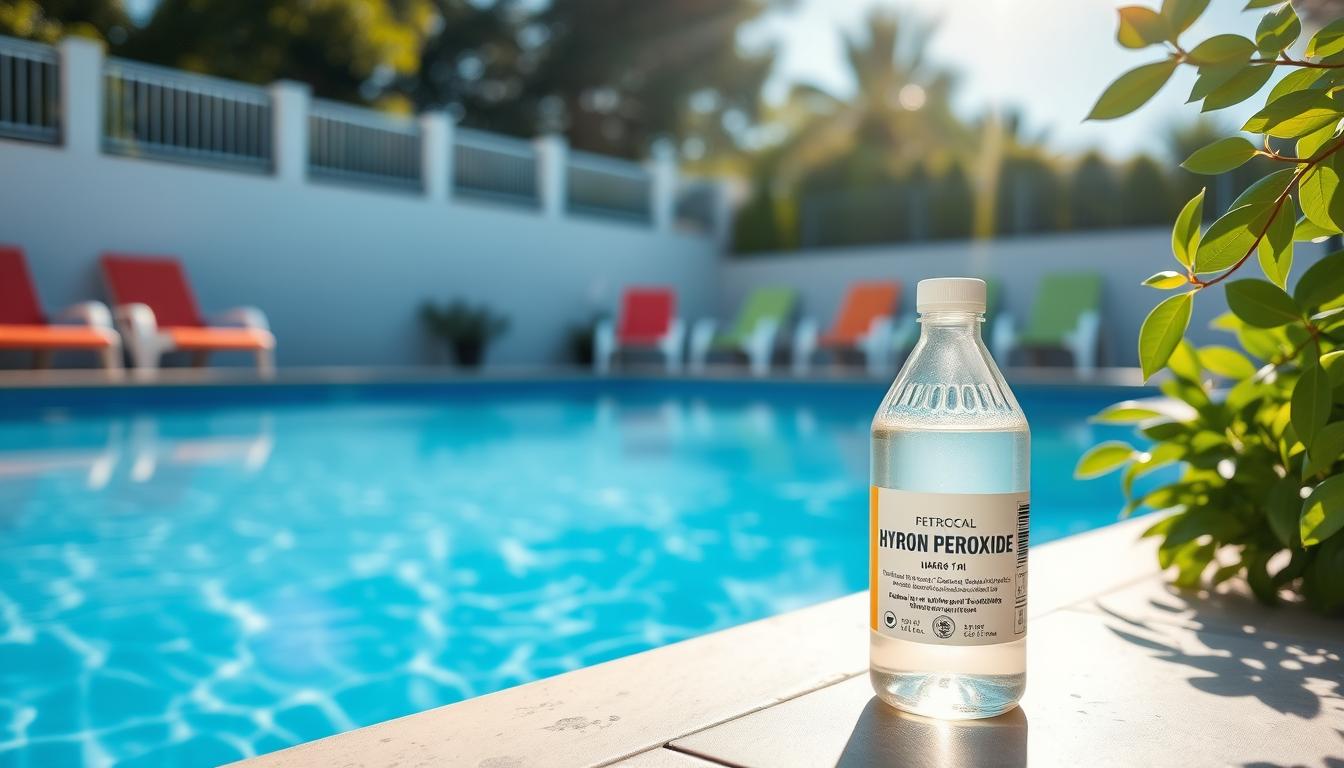
Pool owners know the value of a clean, safe swimming area. Keeping chlorine levels between one and three parts per million (ppm) is key. Too much chlorine can irritate skin and eyes, and create a bad smell.
Hydrogen peroxide can safely reduce high chlorine levels in pools. It neutralizes excess chlorine and restores water balance. But using the right amount is crucial for the best results.
This guide explains how to use hydrogen peroxide for pool chlorine reduction. You’ll learn the science behind it and get step-by-step instructions. We’ll show you how to lower chlorine levels safely and effectively.
Key Takeaways
- Maintaining ideal chlorine levels between one to three ppm is crucial for a safe and enjoyable swimming experience.
- Excessive chlorine levels can cause skin and eye irritation and an unpleasant odor.
- Hydrogen peroxide can be used as a safe and effective solution for chlorine removal from swimming pools.
- Understanding the proper dosage and application techniques is essential for achieving desired results without compromising pool water balance.
- This article will provide a step-by-step guide on how much hydrogen peroxide to use for effective chlorine neutralization in pools.
Understanding the Importance of Chlorine Levels in Pools
Proper chlorine levels are vital for a safe swimming environment. Chlorine kills harmful bacteria and viruses in pool water. Balanced levels are crucial, as too little or too much can be risky.
Chlorine is a powerful disinfectant that eliminates waterborne illnesses. Regular testing ensures the right chemical balance in your pool.
Ideal Chlorine Range for Pool Water
The optimal chlorine range for pool water is 1 to 3 parts per million (ppm). This level effectively sanitizes water and prevents harmful microorganism growth. Regular testing with reliable chlorine testers is essential.
| Chlorine Level (ppm) | Effect on Pool Water |
|---|---|
| 0 – 1 | Insufficient sanitation, risk of bacterial growth |
| 1 – 3 | Ideal range for safe swimming and effective sanitation |
| 3 – 5 | Slightly high, may cause mild irritation to eyes and skin |
| 5+ | Excessive chlorine, potentially dangerous for swimmers |
Risks of High Chlorine Levels
Chlorine levels above 5 ppm can cause health issues for swimmers. These risks include eye and skin irritation, breathing problems, and nausea.
In extreme cases, chlorine poisoning may occur. High levels of combined chlorine can also create unpleasant odors.
- Eye and skin irritation
- Respiratory problems, such as coughing and difficulty breathing
- Nausea and vomiting
- In extreme cases, chlorine poisoning can occur
Pool owners must maintain proper pool water chemistry to ensure safety. Addressing imbalances promptly creates an enjoyable swimming experience for everyone.
Methods for Lowering Pool Chlorine Levels
Maintaining the right balance of chemicals in pools is crucial. Excessive chlorine can cause skin and eye irritation. Here are effective methods to lower chlorine levels in your pool.
Natural Methods: Sunlight and Aeration
Sunlight is a simple way to reduce chlorine levels. UV rays break down chlorine into a gas that escapes into the air. Remove sun covers and encourage swimming to speed up this process.
Running your pool’s aeration system helps release chlorine gas. Water features like fountains and waterfalls can also lower chlorine levels in the water.
Chemical Methods: Sodium Thiosulfate and Ascorbic Acid
Chemical methods offer a faster solution to neutralize chlorine. Sodium thiosulfate and ascorbic acid (vitamin C) are common compounds used for this purpose.
These chemicals react with chlorine to produce harmless byproducts. Follow proper dosage instructions and test the water regularly to avoid over-reducing chlorine levels.
| Chemical | Dosage per 10,000 gallons | Chlorine Reduction |
|---|---|---|
| Sodium Thiosulfate | 2.5 oz | 1 ppm |
| Ascorbic Acid | 1 lb | 1 ppm |
Proper pool chemistry balance is key when using chemical chlorine neutralizers. Regular testing of water pH, salinity, and chlorine levels is necessary.
These pool maintenance tips and chlorine reduction methods will keep your pool water safe. Your swimming experience will be more enjoyable for everyone.
Using Hydrogen Peroxide to Lower Chlorine in Pools
Hydrogen peroxide can effectively lower high chlorine levels in pools. It acts as a powerful oxidizer, keeping pool water clean and clear. Understanding its reaction with chlorine helps restore proper chemical balance.
How Hydrogen Peroxide Reacts with Chlorine
Hydrogen peroxide chemically reacts with chlorine in pool water. It converts chlorine into harmless compounds like water and oxygen. Bubbles may form, showing the hydrogen peroxide is working to reduce chlorine levels.
Determining the Right Amount of Hydrogen Peroxide
Calculating the proper hydrogen peroxide dosage is crucial for effective treatment. Pool size, current chlorine levels, and desired reduction affect the amount needed. Pool-grade hydrogen peroxide with 35% concentration is recommended.
Maintain pool pH between 7.2 and 7.6 for optimal hydrogen peroxide performance. Consider these factors to determine the ideal quantity for your pool.
Step-by-Step Guide: How Much Hydrogen Peroxide to Lower Chlorine in Pool
Start by testing current chlorine levels with a reliable pool testing kit. Calculate the necessary amount of hydrogen peroxide based on pool volume and desired reduction.
Begin with a lower dosage and add more as needed. Monitor chlorine levels throughout the process. Follow these steps to successfully lower chlorine using hydrogen peroxide.
This method ensures a safe and enjoyable swimming experience for you and your loved ones.







